At no previous time in history have people been confronted with so many images on a daily basis.
The billions of photographs and videos now available on the Web—some by professionals and an enormous number by amateurs—are increasingly difficult to interpret. Were the subjects staged?
Was the image manipulated? Was the subject’s privacy respected? Who owns the rights?
What follows is a brief summary of some of the key issues and terms to help consumers make sense of Web based imagery. Sometimes, these terms are placed next to online images to help readers understand what they are looking at, but more often, they are not.
Kinds of Imagery
A conventional or straight photograph is a visual recording of that which was in front of the lens for a fractional second, or what one might think of as a “recording from appearances.” This is often confused with the truth, but as any photographer will acknowledge, each will see and photograph the same situations in different ways. Photographs, like all other media, are interpretive—whether they are meant to be artistic, documentary or journalistic.
Due to the growing sophistication of software that allows seamless retouching and compositing of actual photographs, it may be at times difficult to tell if, for example, a person or place apparently depicted in a photograph ever existed. This has had enormous consequences in the credibility of photography as a recording medium for documenting the world, particularly in journalism.
Obviously, these issues are not as pivotal in advertising or art. The reader understands that in an advertisement much has been done to favorably portray a particular product, and that in art idiosyncratic imaging strategies are to be expected.
The problem in determining what a photograph actually represents is not confined to readers of major news publications. For example, when prosecuting child pornography cases, law enforcement officials now have difficulty proving the child depicted in a photograph really existed.
As a response to these new challenges in the digital era, in May 2008 the U. S. Supreme Court ruled that the pandering of imagery as child pornography, whether or not actual children were depicted, is punishable by law.
A manipulated photograph is one that has been modified after the image was made as a way of enhancing the impact of the image or explicitly deceiving the viewer. A manipulated photograph may also be one that depicts a staged event as if it were spontaneous. While some manipulations represent an obvious intent to falsify what occurred, the reader must be aware that all photographs represent the interpretations of the photographer and depict situations that often have been affected by his or her presence (a portrait would be one example).
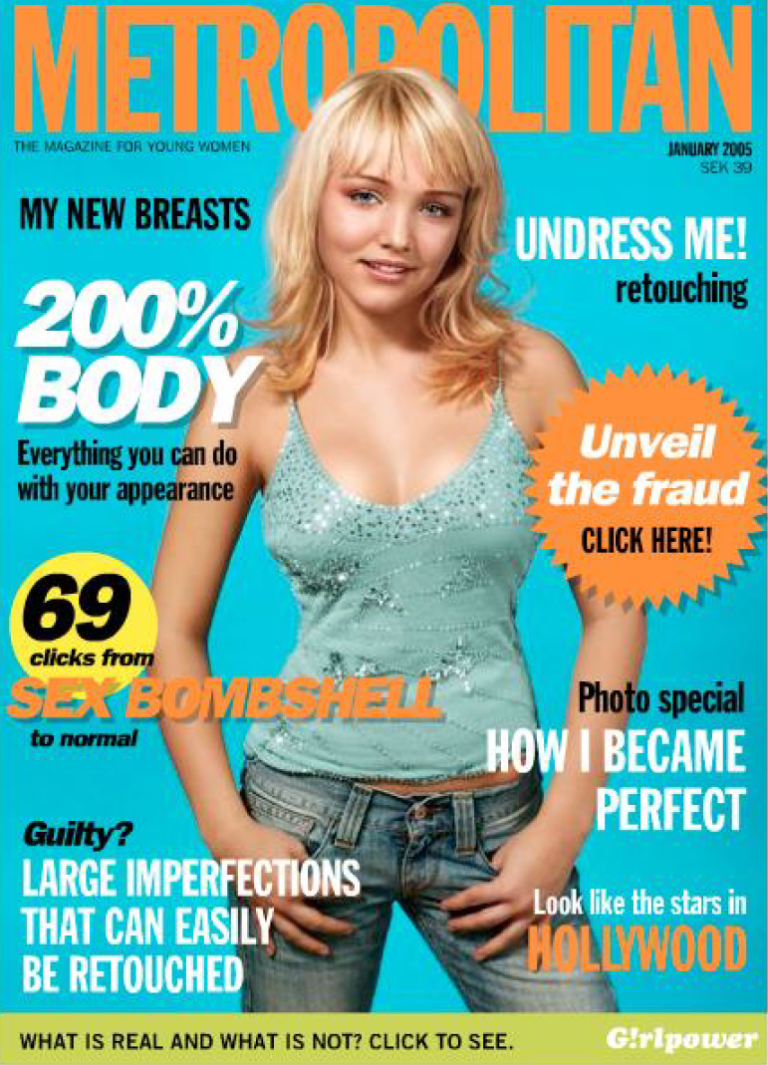
For an interactive illustration of how images may be manipulated, see the Swedish Web site“Girlpower” at: http://demo.fb.se/e/girlpower/retouch/retouch/index.html.
A photo opportunity is an event that has been staged in such a way as to be visually appealing to the press. Politicians, celebrities and others are carefully presented in packaged ways, such as showing a politician with his arm around a factory worker, or standing in front of a landmark that reinforces a particular theme. In these situations, professional photographers and videographers are given access that would normally be denied to amateurs. Nearly all news organizations routinely cover photo opportunities, although some try to show them from a different angle orwrite a caption that allows the reader to understand, at least in a limited way, the degree to which the event has been staged.
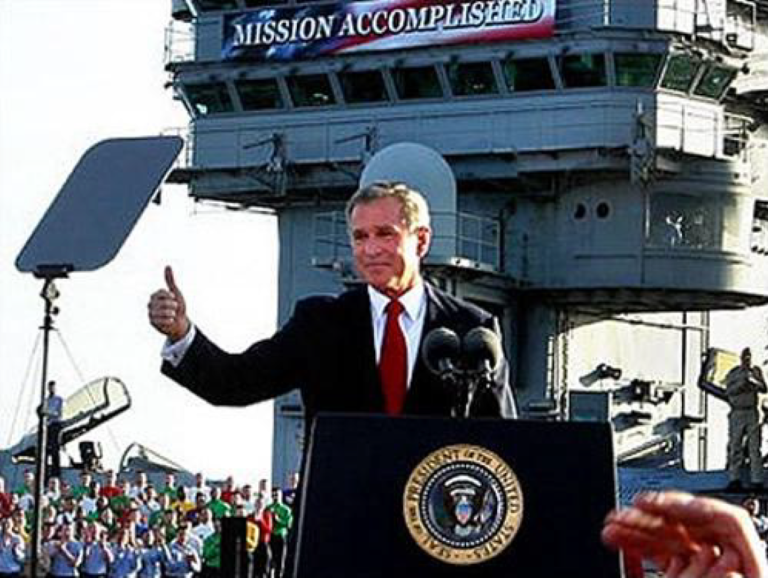
In a carefully choreographed 2003 outing subsequent to the invasion of Iraq, President George W. Bush’s media managers created a photo opportunity on the aircraft carrier USS Abraham Lincoln with the sign “Mission Accomplished” placed in the background.
Photo by Scott Applewhite/AP.
Photo Illustration has two very different meanings. It can be a photograph that is made of a scene that has been staged to illustrate a preexisting concept (for example, a group of short people might be asked to laugh or look happy to illustrate the idea that short people have more fun). Or the term can refer to a photograph that is itself later modified so as to illustrate a concept (for example, retouching a preexisting photograph of short people so that they appear to be smiling). In the first example the subjects knew what they were being asked to do and presumably consented; in the latter example the changes may have been accomplished without their knowledge. While these are very different strategies, the term photo opportunity is used,even among reputable news organizations, to refer to both.
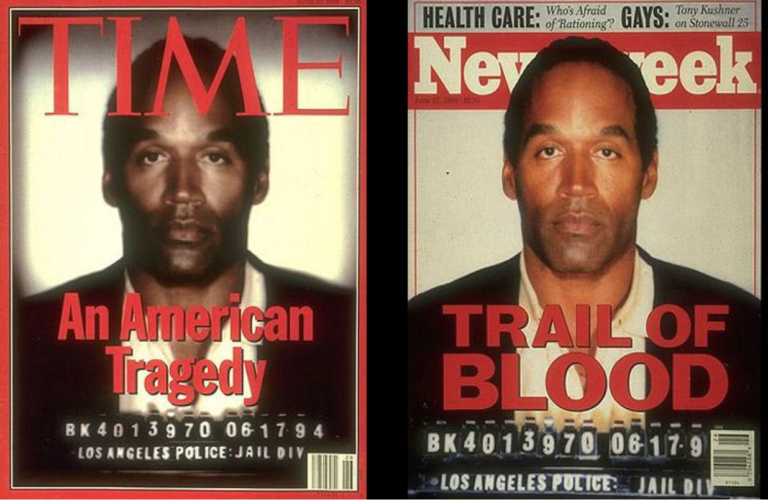
The image on the left of O.J. Simpson was described in the magazine as a photo Illustration; it was derived from the police mug shot, which was reproduced on the right.
A composited image usually refers to the combining of two or more photographs to create the illusion of a single one (putting the image of someone’s head on the image of someone else’s body, for example). All reputable news publications forbid such modifications except when the compositing, in the editors’ opinion, should be obvious to the reader. Many publications also require a caption to identify the image as a composite. Sometimes, as stated above, a composited image will be labeled as a photo illustration.

This image was composited by using two separate photographs of Jane Fonda and John Kerry.The image was then falsely given an Associated Press credit. Several publications ran the image before discovering that it was a fabrication.
A retouched photograph is one that has been partially modified, such as by erasing or adding certain details, darkening or lightening segments, or changing specific colors. Some of these alterations can significantly change the meaning of the photograph (such as by subtracting a liquor bottle from a scene). Most reputable news publications forbid any significant retouching beyond the traditional darkroom techniques of slight darkening or lightening as a way to increase clarity or add some drama. However there is no uniform policy on the treatment of what might be considered minor visual details (such as a pole or a wall outlet in the background); some reputable news organizations may allow them to be erased without informing the reader.
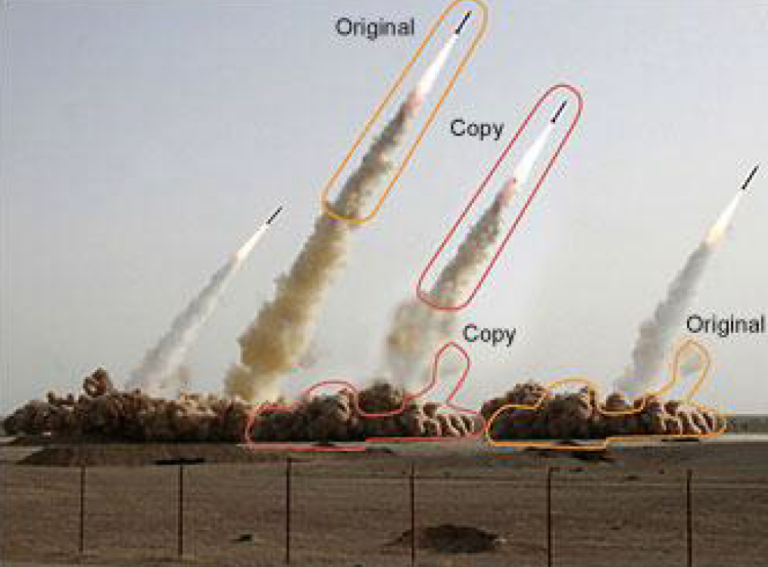
This July 2008 image, released by the Iranian government, purported to show a missile launch. Soon various publications pointed out that it was retouched with certain elements that were cloned to create the impression of an additional missile.
The cropping of an image is an old technique that involves removing a rectangular sliver from any of a photograph’s four sides. Often this is done to remove what are thought to be irrelevant details or excess space as a way of focusing on an image’s more important aspects. Sometimes, however, important contextual information is removed this way. Cropping, like retouching, predates the use of software and has long been done by hand.
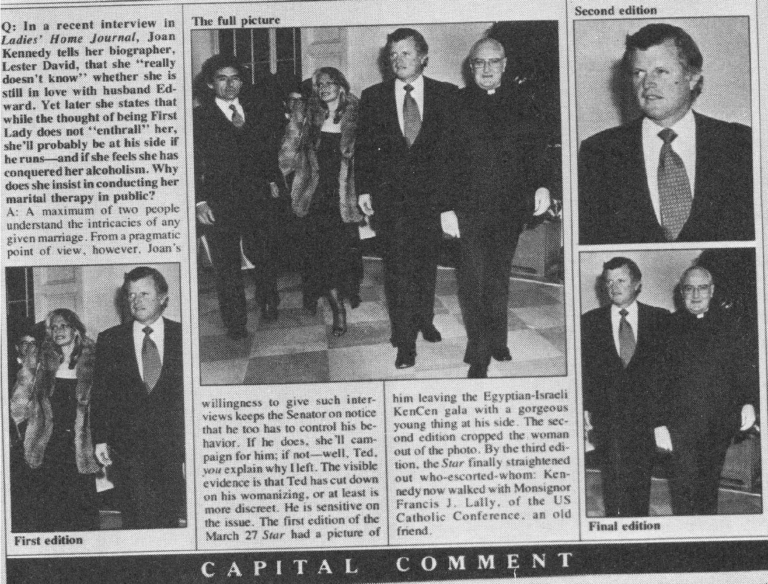
In three editions of one day’s Washington Star newspaper, Senator Edward Kennedy was first shown exiting an Egyptian Israeli Kennedy Center gala with a young woman (left), then by himself (top right), and finally with a monsignor who was an old family friend (bottom right). Each of the very different interpretations of the original photograph (center) was accomplished by cropping, highlighted in a 1979 issue of Washingtonian magazine.
A computer generated image is synthesized mathematically using software and may sometimes look photographic even though nothing has been photographed. Filmmakers now frequently use this technique to create entire animated films such as Toy Story or for special effects, while advertisers use it to make video commercials and ads depicting products with a shiny, modern look. Sometimes publications use this term to refer to composited images that are made from preexisting photographs.
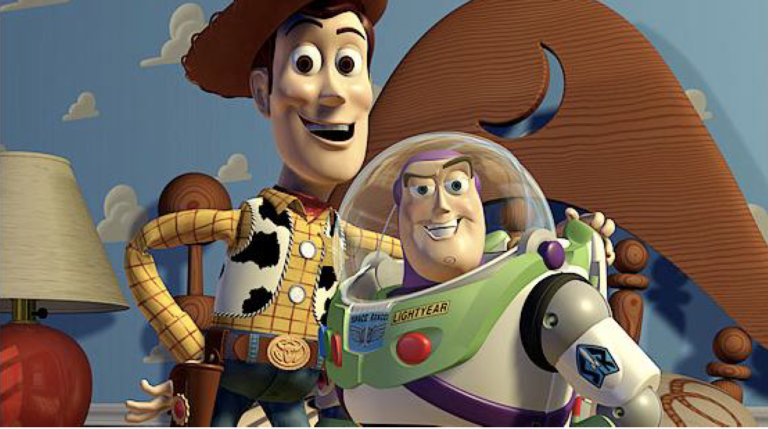
A computer generated image from the popular Disney film, Toy Story.
Intellectual Property Issues
Copyright is a longstanding protection for “original works of authorship” that are fixed in a tangible form of expression. Others cannot, according to U.S. copyright law, reproduce a copyrighted work without express permission from the copyright holder. For more information, visit the U.S.
Copyright Office site: www.copyright.gov
Given the international reach of the World Wide Web, the Digital Millennium Copyright Act of 1998 was passed, in part to acknowledge new issues brought up by digital technologies and the Internet. For example, while Internet service providers are not responsible for copyright infringement incurred by the transmission of information, they are expected to take down material that appears to constitute copyright infringement.
But given the extraordinary ease with which imagery can be replicated on the Internet, many individual authors have had little success stopping the appropriation of their materials. Large numbers of people now apparently believe that anything published on the Web can be taken by others, modified and reused.
Many see this as a form of flattery. It is difficult, given the fluid nature of the Web, its international reach and idiosyncratic culture, to feel certain of the ability to protect one’s work from being repurposed.
Some photo and video sharing sites such as Flickr and YouTube encourage a community of viewers to comment upon, link to and share work. Others, such as Shutterfly or Kodak Gallery, emphasize the creation of private galleries that are accessible only for one’s appointed guests.
Creative Commons is a not for profit organization that has come up with numerous ways an author can choose to license imagery and other intellectual property that ranges between full copyright (all rights reserved) and public domain (no rights reserved). For example, an author may let others freely use the image as long as the image is properly credited, or may elect to let others use the image or derivative works but only for noncommercial purposes. For more information, visit: http://creativecommons.org
Moral rights are asserted in certain countries such as France and Germany ensuring the right of the author of a particular work—whether or not he or she still owns that work—to object to any subsequent modifications to that may be viewed as derogatory. For example, a movie originally shot in black and white could not be colorized without the director’s permission, no matter who owns the copyright.
Fair use refers to the legal right, in limited situations, to reproduce a section of a copyrighted work without violating the copyright holder’s rights. These situations might include scholarship, criticism, teaching or parody. There are four factors given by the U.S. copyright law (section 107) to determine fair use, including the “purpose and character of the use,” “the nature of the copyrighted work,” “the amount and substantiality of the portion used,” and the “effect of the use upon the potential market for or value of the copyrighted work.” Given the ambiguity of the law,and its application on a case by case basis, the government counsels that the “safest course is always to get permission from the copyright owner.” For more information on the fair use doctrine, visit: www.copyright.gov/fls/fl102.html
Public domain refers to work that is without copyright protection either because it comes from a public source such as the government or because copyright protection has lapsed. While copyright protection varies among countries, works published in the United States after the year2002 are now copyright protected for 70 years after the death of the author. If a corporation created the work, copyright protection extends for 95 years after its first publication. See an informative chart on this subject at: www.copyright.cornell.edu/public_domain
Privacy Issues
While there is little legal protection from being photographed by other individuals for a person walking down the street, there are certain legally defensible expectations of privacy in one’s own home, a school or hospital, or in situations such as a dressing room. The Video Voyeurism Act of 2004 protects one from being photographed in situations where there is a “reasonable expectation of privacy” such as a locker room. However, it may be difficult to determine, given the ubiquity of camera equipped cell phones and the further miniaturization of cameras, whether someone is photographing at any given moment.
At the same time the enormous numbers of surveillance cameras on streets, surrounding buildings, inside stores, banks, offices and schools make such expectations of privacy somewhat unrealistic. In an urban area one can expect to be photographed throughout one’s day. While photography by individuals may not be allowed, institutional surveillance, somewhat paradoxically, is widespread.
One’s own photographs or videos placed in a profile on Facebook or MySpace may also be seen by others that they were not intended for, including prospective employers. The New York City Police Department has recently joined the ranks of those doing background checks using these kinds of sites.
Back to Glossary
